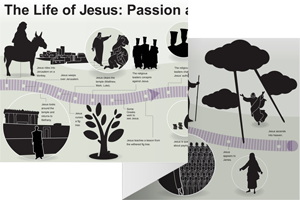21:1–25 John ends his Gospel with an epilogue in which Jesus appears again to His disciples in Galilee and offers encouragement to them, charging Peter to care for His followers. |
 Resurrection Appearances of Jesus Table
Resurrection Appearances of Jesus Table
21:2 Simon Peter See note on Matt 10:2. Peter had denied Jesus three times, just as Jesus had prophesied.
Thomas See note on John 20:24. Thomas had doubted that Jesus was resurrected when the others told him that they had seen Him.
Nathanael See 1:45. Nathaniel had acknowledged Jesus as the king of Israel early on (1:49), but he had initially doubted Philip’s claim that the Messiah had come from Nazareth (1:45).
Cana in Galilee The village where Jesus performed His first miracle (see note on 2:1), which began His ministry in the Gospel of John (see 2:1–12 and note). The only ministry work Jesus did prior to this was calling His disciples (1:35–42).
21:3 I am going fishing Peter returns to his original occupation. As a leader of the group, he leads the others to do the same (Mark 1:16–20).
Miracles Unique to John’s Gospel | ||
Water to Wine, John 2:1–11 | Official’s Son Healed, 4:46–52 | Paralytic Healed, 5:1–13 |
Blind Man Healed, 9:1–12 | Lazarus Raised, 11:38–44 | Great Catch of Fish, 21:1–14 |
21:7 disciple whom Jesus loved Likely refers to John the evangelist (the apostle). See note on 13:23.
his outer garment Peter may have been nude, or he may have been wearing an undergarment to work in (the Greek of this verse can mean either). In any case, Peter takes his outer robe with him so that he can go ashore clothed.
21:13 took the bread This might have reminded Jesus’ disciples of their last meal together.
21:14 third time John is probably referring to the first two appearances mentioned in his Gospel (20:19–23, 26–29).
21:15–19 Jesus reaffirms Peter’s calling following his denial (18:15–27). Since Peter had denied three times that he knew Jesus, Jesus asks three times whether Peter loves him. |
21:15 love Jesus begins His series of questions by using the word agapaō.
than these Jesus may be asking Peter whether he loves Him more than the other disciples do—forcing him to acknowledge his shortcomings as one who had denied Jesus (John 18:15–18, 25–27). Jesus also could be asking Peter whether he loves Him more than he loves his fellow disciples.
love Peter responds by using the word phileō; he seems to be responding with a quick affirmation, choosing a synonym for agapaō.
21:16 love Rather than responding with the word Peter used (phileō), Jesus again uses agapaō. He repeats the first part of His question verbatim, but leaves off the “more than these” part. In doing so, He is emphasizing the part that He wants Peter to remember and understand.
love Peter does not understand the purpose of Jesus’ repetition and responds as before, using phileō and emphasizing that Jesus already knows the answer.
Shepherd Jesus instructs Peter to guide His people (compare 10:11–15).
21:17 distressed Peter seems to understand that Jesus’ three questions parallel his three denials. He is grieved by being forced to remember his failing in front of the one whom he had denied.
you know everything Peter affirms what he and the other disciples had articulated after Jesus explained God’s plans for salvation to them (John 14–16; see note on 16:30).
21:18 tie you up and carry you Jesus is referring to Peter’s death. According to church tradition, he was crucified upside down in Rome roughly 30 years after Jesus’ ministry (see note on 1 Pet 5:1).
21:19 Follow me Jesus’ central command since the beginning of His ministry (John 1:43). It is the essence of His other command about eternal life coming through Him (12:50) and His subsequent commands to love others (13:34; compare 12:25).
21:21 what about this one Peter likely is inquiring about John (see note on 13:23).
21:22 what is that to you Jesus tells Peter that he should not be concerned with God’s will for others.
21:23 that he would not die Apparently, Jesus’ saying caused confusion. John emphasizes that Jesus’ statement was not a prediction, but rather a hypothetical scenario intended to instruct Peter.
21:24 this is the disciple Refers to author of this Gospel. See note on 13:23.
we know that his testimony is true An editor may have written this postscript based on the eyewitness accounts of John.
21:25 many other things John acknowledges that the Gospels don’t record everything that Jesus did. What they include was recorded to encourage belief in Jesus (see 20:31 and note).

|
About Faithlife Study BibleFaithlife Study Bible (FSB) is your guide to the ancient world of the Old and New Testaments, with study notes and articles that draw from a wide range of academic research. FSB helps you learn how to think about interpretation methods and issues so that you can gain a deeper understanding of the text. |
| Copyright |
Copyright 2012 Logos Bible Software. |
| Support Info | fsb |
 Loading…
Loading…

